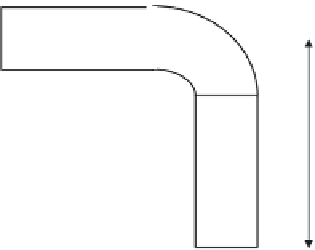Environmental Engineering Reference
In-Depth Information
figure 4.18 Expanded-end hose.
synthetic cord). The hose is said to be
mandrel braided
, because a spin-
dle or core (the mandrel) is inserted into the tube before the reinforcing
materials are put on. The mandrel provides a firm foundation over which
the cords are evenly and tightly braided. The
cover
of the hose is an
outer, protective covering. The hose in Figure 4.17 has a cover of tough,
abrasion-resistant material.
The
overall length
is the true length of a straight piece of hose.
Hose that is not too flexible is formed or molded in a curve (e.g., auto-
mobile hose used in heating systems) (see Figure 4.19). As shown in
Figure 4.19, the
arm
is the section of a curved hose that extends from
the end of the hose to the nearest centerline intersection. The
body
is
the middle section or sections of the curved hose. Figure 4.20 shows the
bend radius
(i.e., the radius of the bend measured to the centerline) of
the curved hose, designated as radius
r
. In a straight hose, bent on the
job, the radius of the bend is measured to the surface of the hose (i.e.,
radius
r
in Figure 4.20).
Note:
Much of the nomenclature used above does not apply to nonmetal-
lic hose that is not reinforced; however, nonreinforced nonmetallic hose
is not very common in water/wastewater treatment plant operations.
Body
R
Arm
figure 4.19 Bend radius.

















